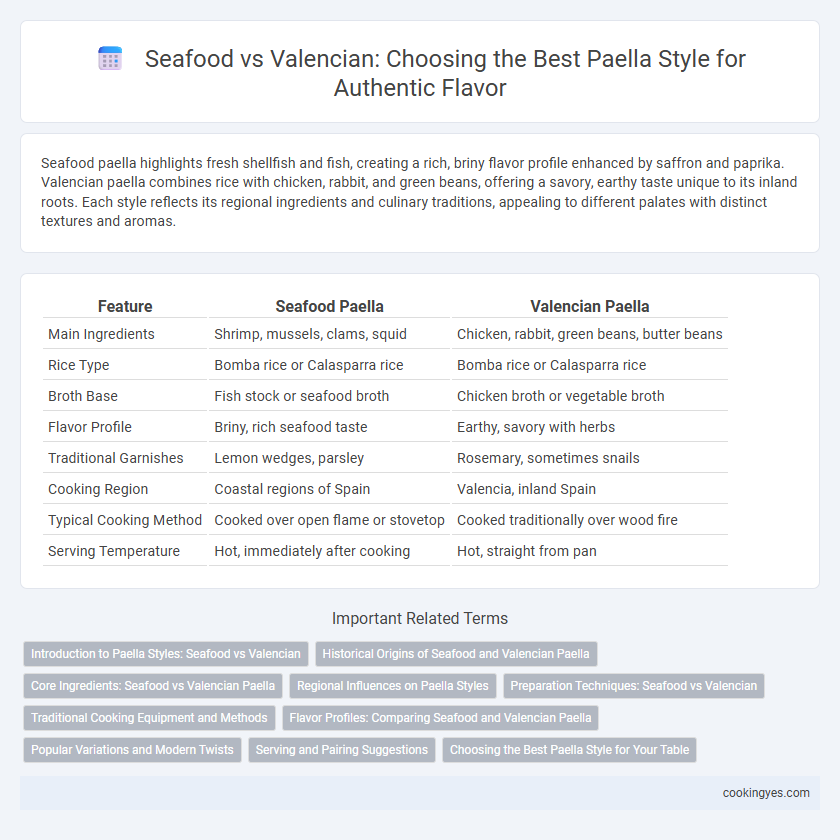Seafood paella highlights fresh shellfish and fish, creating a rich, briny flavor profile enhanced by saffron and paprika. Valencian paella combines rice with chicken, rabbit, and green beans, offering a savory, earthy taste unique to its inland roots. Each style reflects its regional ingredients and culinary traditions, appealing to different palates with distinct textures and aromas.
Table of Comparison
| Feature | Seafood Paella | Valencian Paella |
|---|---|---|
| Main Ingredients | Shrimp, mussels, clams, squid | Chicken, rabbit, green beans, butter beans |
| Rice Type | Bomba rice or Calasparra rice | Bomba rice or Calasparra rice |
| Broth Base | Fish stock or seafood broth | Chicken broth or vegetable broth |
| Flavor Profile | Briny, rich seafood taste | Earthy, savory with herbs |
| Traditional Garnishes | Lemon wedges, parsley | Rosemary, sometimes snails |
| Cooking Region | Coastal regions of Spain | Valencia, inland Spain |
| Typical Cooking Method | Cooked over open flame or stovetop | Cooked traditionally over wood fire |
| Serving Temperature | Hot, immediately after cooking | Hot, straight from pan |
Introduction to Paella Styles: Seafood vs Valencian
Seafood paella highlights fresh shellfish and fish, infusing the rice with rich ocean flavors and saffron aroma. Valencian paella, the traditional origin, combines rabbit, chicken, and green beans, emphasizing rustic, earthy tastes from Mediterranean ingredients. Both styles reflect distinct regional ingredients, showcasing paella's versatility and cultural heritage.
Historical Origins of Seafood and Valencian Paella
Seafood paella, rooted in coastal regions of Spain, evolved from the abundant availability of fresh marine ingredients, highlighting shrimp, mussels, and clams as key components that reflect Mediterranean culinary traditions. Valencian paella, originating in the inland region of Valencia during the 18th century, traditionally combines local chicken, rabbit, and green beans, representing the agrarian lifestyle and ingredients native to the Valencian countryside. Historical records emphasize the distinct regional influences that shaped these two iconic paella styles, preserving their unique cultural and gastronomic identities.
Core Ingredients: Seafood vs Valencian Paella
Seafood paella centers on fresh shrimp, mussels, clams, and squid, combined with short-grain bomba rice, saffron, garlic, and tomatoes to create a rich maritime flavor. Valencian paella features core ingredients such as rabbit, chicken, green beans, garrofon beans, and sometimes snails, all simmered with bomba rice, saffron, rosemary, and paprika for a traditional inland taste. Both styles rely on high-quality bomba rice and saffron but showcase distinct regional protein and vegetable choices that define their unique identities.
Regional Influences on Paella Styles
Seafood paella, popular along Spain's Mediterranean coast, highlights fresh shellfish, shrimp, and mussels, influenced by the region's abundant marine resources. Valencian paella, rooted in the inland Valencia region, traditionally combines chicken, rabbit, and green beans, reflecting local agricultural practices. These regional differences underscore how geography and ingredient availability shape distinct paella styles across Spain.
Preparation Techniques: Seafood vs Valencian
Seafood paella requires careful timing to cook delicate shellfish, squid, and fish just right, often added towards the end to prevent overcooking, while Valencian paella focuses on slow-cooking chicken, rabbit, and green beans with sofrito to develop deep, savory flavors. Seafood paella uses a fish or seafood broth base and typically includes ingredients like mussels, clams, and shrimp, emphasizing freshness and timing. Valencian paella relies on a traditional meat stock and a longer simmering process to tenderize proteins and infuse the rice with a rich, hearty essence.
Traditional Cooking Equipment and Methods
Traditional paella cooking relies on a wide, shallow pan called a paellera, essential for even heat distribution and the signature socarrat crust. Seafood paella often utilizes a slightly thinner pan to accommodate delicate shellfish, while Valencian paella uses a thicker paellera to handle the longer cooking times of ingredients like rabbit and chicken. Both styles traditionally cook over an open flame or wood fire, infusing the dish with a smoky flavor that gas burners cannot replicate.
Flavor Profiles: Comparing Seafood and Valencian Paella
Seafood paella delivers a briny, oceanic flavor profile enriched by ingredients like mussels, shrimp, and squid, accentuated with saffron and smoky paprika. Valencian paella balances savory notes from rabbit, chicken, and green beans, highlighting earthy and herbaceous undertones combined with the nuttiness of bomba rice. The contrast lies in the seafood's fresh, marine essence versus Valencian's hearty, rustic taste rooted in traditional land-based ingredients.
Popular Variations and Modern Twists
Seafood paella, renowned for its rich mix of shrimp, mussels, clams, and squid, highlights coastal flavors and fresh ocean ingredients, appealing to those who prefer a lighter, briny taste. Valencian paella, the traditional origin of paella, centers on rabbit, chicken, green beans, and snails, emphasizing rustic, earthy flavors deeply rooted in the Valencia region's agricultural heritage. Modern twists often blend these styles or introduce ingredients like chorizo, artichokes, or vegan substitutes, catering to contemporary palettes and expanding the versatility of this iconic Spanish dish.
Serving and Pairing Suggestions
Seafood paella, rich with mussels, shrimp, and clams, pairs excellently with crisp white wines like Albarino or Verdejo, enhancing the dish's oceanic flavors and light, zesty notes. Valencian paella, featuring rabbit, chicken, and green beans, complements fuller-bodied red wines such as Tempranillo or Garnacha, which balance its earthy, savory taste profile. Serve seafood paella with lemon wedges to intensify freshness, while valencian paella benefits from a fresh garden salad to complement its hearty ingredients.
Choosing the Best Paella Style for Your Table
Seafood paella showcases an array of fresh shellfish and fish, offering a rich, briny flavor ideal for coastal dining experiences. Valencian paella, originating from Spain's Valencia region, features traditional ingredients like chicken, rabbit, green beans, and sometimes snails, delivering a rustic and hearty taste. Selecting the best paella style depends on your preference for either the maritime freshness of seafood or the earthy, robust profile of Valencian paella's land-based components.
Seafood vs Valencian for Paella style Infographic

 cookingyes.com
cookingyes.com